
(Photos © J. Maus/BikePortland)
The Oregon Transportation Commission has reached a crossroads when it comes to the I-5 Rose Quarter megaproject.
The governing body of the Oregon Department of Transportation is poised to make a decision later this month about whether to drive ahead with the estimated $500 million project or whether to hit the brakes and perform a more thorough assessment of its environmental impacts.
Thus far, ODOT’s analysis of the project’s potential impact to the earth and to our community has been severely lacking. And that’s not just according to activists who oppose the project. Back in April, Metro’s senior planner described ODOT’s work on the project “inadequate and potentially misleading.”
In August, ODOT hinted that they’d heed the groundswell of community leaders and voices calling for a full Environmental Impact Statement (EIS) as part of the National Environmental Protection Act process they’re mandated to comply with. To date, ODOT has completed only an Environmental Assessment (EA) which is a less robust process.
As a decision from the OTC gets closer, pressure to slow down and do the EIS is building.
Advertisement
Willamette Week just reported that Oregon House Speaker Tina Kotek now supports calls for a full EIS. Kotek seems to have been convinced by the Portland Public School Board, who has already made their demands for an EIS clear and will consider another resolution on the project at their meeting later today.
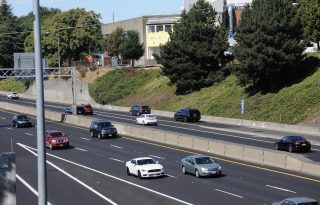
PPS Board members are paying close attention because ODOT’s plans for widening I-5 would inch the freeway ever-closer to the playground and classrooms of students at Harriet Tubman Middle School. “The historical legacy from ODOT ignoring health and equity concerns voiced decades ago about building a freeway too close to a school has cost PPS millions of dollars that were used to make the air inside Tubman safe for students and had health and environment consequences for our students and the surrounding community,” the Board states in the resolution they’ll consider tonight (PDF).
Here’s more from PPS:
“Although the proposed project is immediately adjacent to PPS properties, in particular Harriet Tubman Middle School, neither ODOT nor the City meaningfully engaged with PPS during the planning process to assess the potential impacts, either short- or long-term, on the health of students and staff from environmental hazards of the freeway and the expansion or on the structural integrity of PPS facilities from incursions on PPS property during construction.
An initial review of the EA by PPS staff raised substantial questions about potential impacts on PPS properties, including risks to soil stability under the Harriet Tubman Middle School site during the construction process, increased air pollution, increased noise pollution, lack of school bus egress from Harriet Tubman Middle School with the removal of the Flint Street overpass, and shifts to traffic patterns in the vicinity of both Tubman and District headquarters…
In June 2019, ODOT convened a group of elected leaders and staff as well as community stakeholders to discuss the I-5 Rose Quarter Improvement Project in the Albina neighborhood.
To date, this group has met five times and made no substantial progress to substantially address issues raised by Portland Public Schools and the Albina Vision or offer alternatives to the current project plan.
At this time, the OTC has privately stated that it plans to unilaterally take action at its December 17 public meeting without addressing any of the troubling and significant impacts that the widening will have on students and community health.”
In the name of “climate justice” the PPS Board is expected to pass the resolution that reiterates their calls for a full EIS that addresses, “the long term health and environmental issues at Harriet Tubman Middle School caused by the I-5 freeway.” They will also formally state their intention to work with Albina Vision Trust on broader, neighborhood impacts of the freeway and share their findings with state legislators and the wider community.
“I’m definitely sympathetic to the folks who say we can’t do any more highway infrastructure because we’ve gotta’ get out of our cars because we’re killing the planet. I also know that, there’s no way people are going to stop driving tomorrow.”
— Tina Kotek, Oregon House Speaker
Also upping the pressure on ODOT and the OTC is a rally being planned by the No More Freeways group. On December 10th they plan to host an “Accountability for ODOT Rally” in front of the agency’s Portland headquarters.
As for Speaker Kotek, her call for an EIS will embolden the project’s opponents, but they shouldn’t count on her to help them stop it.
Kotek struck a compromised view of the project at the November meeting of the Portland Freight Committee. “I’m definitely sympathetic to the folks who say we can’t do any more highway infrastructure because we’ve gotta’ get out of our cars because we’re killing the planet,” she said. “I also know that, there’s no way people are going to stop driving tomorrow.”
Advertisement
“You have people saying any kind of improvement is increasing capacity and that’s a bad thing. I do believe we need to have more through traffic. The auxiliary lane is not expansion, it’s just better fluidity in the Rose Quarter and that’s what we need. And at the same time, I want people out of their cars and we need more transit. But again, going back to funding sources, how does transit get supported? We have the statewide payroll tax, but I’m sure TriMet thinks they need more money to expand capacity, so that is a conversation we should get to.
I think people should just not go to their corners and just keep lobbing bombs. And what I’m hearing from some parts of the freight community is that we were promised another lane. OK, I don’t think you were. So, what we need is an auxiliary lane. It’s like, come on people… we’re not going to get this done if we don’t stop fighting.”
— Jonathan Maus: (503) 706-8804, @jonathan_maus on Twitter and jonathan@bikeportland.org
— Get our headlines delivered to your inbox.
— Support this independent community media outlet with a one-time contribution or monthly subscription.



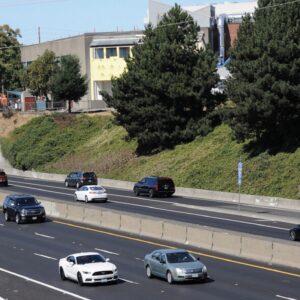
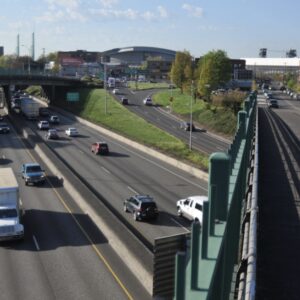
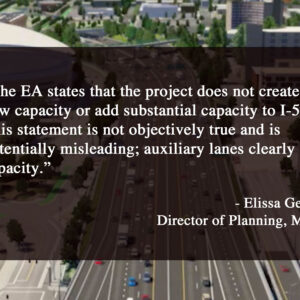
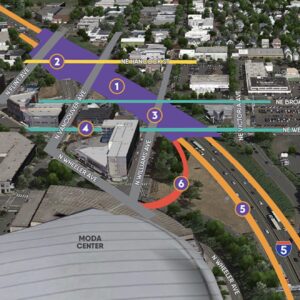
Thanks for reading.
BikePortland has served this community with independent community journalism since 2005. We rely on subscriptions from readers like you to survive. Your financial support is vital in keeping this valuable resource alive and well.
Please subscribe today to strengthen and expand our work.
Does anyone know what the criteria are for deciding if a full EIS is required? Surely it isn’t strictly a political decision.
This project is clearly a prelude to an expanded CRC project, so it bears careful scrutiny.
and yet, I-5 narrows to two lanes just south of this project, regardless…just go stand on the Flint overpass and look. Nothing will change to the south without taking down the Vancouver and Williams overpasses too…
Save the Flint Ave. overpass! Best bike and pedestrian route; N. Vancouver is a motor vehicle sewer at the I-5 Broadway interchange, no one wants to ride their bicycle there.
The CRC must include high capacity transit as signed in a memo between Inslee and Brown a few weeks ago. It bears careful scrutiny that any additional mega freeway project include a high capacity transit option analysis along with the CRC work. This is what an EIS would do; study options. ODOT decided they know the correct option is an auxiliary lane. Tina Kotek may have promised pork barrel projects to her big money freight donors, but that doesn’t absolve the State of Oregon from following the rules of the National Environmental Protection Act. In deed, these rules were put in place to address this very problem: undue burden placed on existing vulnerable populations. We encourage all state staff to consider high capacity transit options before committing $500 million dollars to mega projects we can no longer afford and increase GHG emissions.
“I’m definitely sympathetic to the folks who say we can’t do any more highway infrastructure because we’ve gotta’ get out of our cars because we’re killing the planet,” she said. “I also know that, there’s no way people are going to stop driving tomorrow.”
Pathetic.
By always and forever abetting the status quo you assuredly get what you already have, just more of it. No thank you.
to really impact climate change, 90% of driving should have stopped ‘yesterday’!
But good luck with that….
This sounds like a person who has no fear of the primary election.
This sounds like a person who has no conception of what leadership entails, what it means to stand up for a principle.
What I don’t like about these sorts of comments is that they depend entirely on whether you happen to agree with the viewpoint being stood up for. That is, it’s only “leadership” when you agree with the principle being defended. Otherwise it’s “obstructionism” or something.
If a person is defending a principle you don’t like (like ensuring adequate highway capacity, for example), would you still recognize that as “leadership”?
“If a person is defending a principle you don’t like (like ensuring adequate highway capacity, for example), would you still recognize that as “leadership”?”
Not all priorities or principles have the same weight, improve the human condition. Some priorities seek to accomplish the opposite. It is generally possible to compare principles, assess whether they serve all or just a few, advance humanity or retard it.
Bull Connor probably thought he was exercising leadership too when he enforced racial segregation and used dogs and fire hoses on the blacks citizens of Alabama. Our current president would like to imagine that he is exercising leadership when he shouts about building a wall and puts migrant children in cages, but we might agree that this is not leadership but demagoguery.
I think your example of ‘adequate highway capacity’ fails the leadership test on two fronts. One, which Ivan Illich figured out for us forty-plus years ago, reveals the project to be elusive, impossible due largely to the by now well-known phenomenon of induced demand. But even if that were not the case, a stable climate/habitable planet, which the pursuit of ‘adequate highway capacity’ dooms, is easily recognized as a higher-order principle. Expanding highway capacity is the putative answer to a design problem, for which there are hundreds of better solutions. A habitable planet is not a design problem but a system condition everything else depends on. Leadership can distinguish between these levels and resists the temptation to pander to short term interests at the expense of higher order principles.
“Drive ahead” LOLZ
sorry, ‘drive ahead’??? I’m not a proponent of the project but this is not neutral reporting, either…
tldr– Maus said this is his own damn blog that he owns not bloody NPR (avid listener here).
Forty years of “neutral reporting” since inquiring minds saw climate changes was in the pipeline, so to speak, and the only real question now is whether the (s word) is up to our knees or up to our nipples.
We seem to be moving on from nipple-high to somewhere between mouth and nose height. It might be time to do something about it.
This is a blog, not the New York Times.
I’m baffled by the amount of new freeway pavement in the area. None of it helps ease congestion. What it does do is create more law-breaking drivers trying to get out of these slip lanes and causing congestion in the new lane as a result, and make it tougher for law-abiding drivers to get onto the freeway by being forced onto the next exit instead of the freeway because you can’t legally escape the slip lane.
I’m saddened that this is still allowed to happen and that people in higher seats of power are doing nothing to stop it.